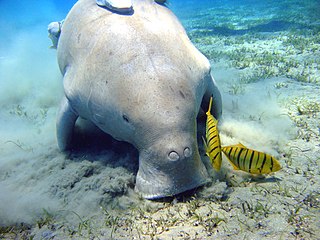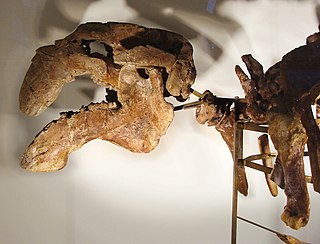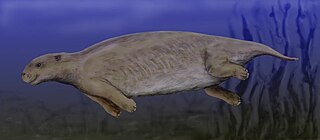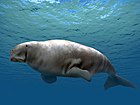
The Sirenia, commonly referred to as sea cows or sirenians, are an order of fully aquatic, herbivorous mammals that inhabit swamps, rivers, estuaries, marine wetlands, and coastal marine waters. The extant Sirenia comprise two distinct families: Dugongidae and Trichechidae with a total of four species. The Protosirenidae and Prorastomidae families are extinct. Sirenians are classified in the clade Paenungulata, alongside the elephants and the hyraxes, and evolved in the Eocene 50 million years ago (mya). The Dugongidae diverged from the Trichechidae in the late Eocene or early Oligocene.

Dugongidae is a family in the order of Sirenia. The family has one surviving species, the dugong, one recently extinct species, Steller's sea cow, and a number of extinct genera known from fossil records.

Marine mammals are mammals that rely on marine (saltwater) ecosystems for their existence. They include animals such as cetaceans, pinnipeds, sirenians, sea otters and polar bears. They are an informal group, unified only by their reliance on marine environments for feeding and survival.

Steller's sea cow is an extinct sirenian described by Georg Wilhelm Steller in 1741. At that time, it was found only around the Commander Islands in the Bering Sea between Alaska and Russia; its range extended across the North Pacific during the Pleistocene epoch, and likely contracted to such an extreme degree due to the glacial cycle. It is possible indigenous populations interacted with the animal before Europeans. Steller first encountered it on Vitus Bering's Great Northern Expedition when the crew became shipwrecked on Bering Island. Much of what is known about its behavior comes from Steller's observations on the island, documented in his posthumous publication On the Beasts of the Sea. Within 27 years of its discovery by Europeans, the slow-moving and easily-caught mammal was hunted into extinction for its meat, fat, and hide.

The Desmostylia are an extinct order of aquatic mammals native to the North Pacific from the early Oligocene (Rupelian) to the late Miocene (Tortonian). Desmostylians are the only known extinct order of marine mammals.

Hydrodamalis is a genus of extinct herbivorous sirenian marine mammals. It included the Steller's sea cow, the Cuesta sea cow, and the Takikawa sea cow. The fossil genus Dusisiren is regarded as the sister taxon of Hydrodamalis: together, the two genera form the dugong subfamily Hydrodamalinae. They were the largest member of the order Sirenia, whose only extant members are the dugong and the manatees. They reached up to 9 metres (30 ft) in length, making the Steller's sea cow among the largest mammals other than whales to have existed in the Holocene epoch. Steller's sea cow was first described by Georg Wilhelm Steller,

The Amazonian manatee is a species of manatee that lives in the Amazon Basin in Brazil, Peru, Colombia and Ecuador. It has thin, wrinkled brownish or gray colored skin, with fine hairs scattered over its body and a white chest patch. It is the smallest of the three extant species of manatee.

Paleoparadoxia is a genus of large, herbivorous aquatic mammals that inhabited the northern Pacific coastal region during the Miocene epoch. It ranged from the waters of Japan, to Alaska in the north, and down to Baja California, Mexico.

Hydrodamalinae is a recently extinct subfamily of the sirenian family Dugongidae. The Steller's sea cow was hunted to extinction by 1768, while the genus Dusisiren is known from fossils dating from the middle Miocene to early Pliocene.

Desmostylus is an extinct genus of herbivorous mammal of the family Desmostylidae living from the Chattian stage of the Late Oligocene subepoch through the Late Miocene subepoch and in existence for approximately 21.2 million years.

Sirenia is the order of placental mammals which comprises modern "sea cows" and their extinct relatives. They are the only extant herbivorous marine mammals and the only group of herbivorous mammals to have become completely aquatic. Sirenians are thought to have a 50-million-year-old fossil record. They attained modest diversity during the Oligocene and Miocene, but have since declined as a result of climatic cooling, oceanographic changes, and human interference. Two genera and four species are extant: Trichechus, which includes the three species of manatee that live along the Atlantic coasts and in rivers and coastlines of the Americas and western Africa, and Dugong, which is found in the Indian and Pacific oceans.

Eotheroides is an extinct genus of Eocene sirenian. It is an early member of the family Dugongidae, which includes the extant dugong. Fossils have been found from Egypt, India, and Madagascar. Eotheroides was first described by Richard Owen in 1875 under the name Eotherium, which was replaced by the current name in 1899.

Metaxytherium is an extinct genus of dugong that lived from the Oligocene until the end of the Pliocene. Fossil remains have been found in Africa, Europe, North America and South America. Generally marine seagrass specialists, they inhabited the warm and shallow waters of the Paratethys, Mediterranean, Caribbean Sea and Pacific coastline. American species of Metaxytherium are considered to be ancestral to the North Pacific family Hydrodamalinae, which includes the giant Steller's sea cow.

Protosiren is an extinct early genus of the order Sirenia. Protosiren existed throughout the Lutetian to Priabonian stages of the Middle Eocene. Fossils have been found in the far-flung locations like the United States, Africa (Egypt), Europe and Asia.

Prorastomidae is a family of extinct sirenians from Jamaica, related to the extant manatees and dugong. The family includes the oldest known fossils of Sirenians, represented in two genera:

The Cuesta sea cow is an extinct herbivorous marine mammal and is the direct ancestor of the Steller's sea cow. They reached up to 9 metres (30 ft) in length, making them among the biggest sirenians to have ever lived. They were first described in 1978 by Daryl Domning when fossils in California were unearthed. Its appearance and behavior are largely based on that of the well-documented Steller's sea cow, which, unlike the Cuesta sea cow, lived into the modern era and was well-described.

The Takikawa sea cow is an extinct herbivorous marine mammal of the Late Pliocene which was closely related to the recently extinct Steller's sea cow. In 1988, fossils of sea cows were discovered in Hokkaido and were originally assigned to the Takikawa sea cow, a newly described species, even though this taxon is thought of by some scientists as a synonym of the Cuesta sea cow. It is uncertain whether or not the Takikawa sea cow was simply a local variant of the Cuesta sea cow or a completely separate lineage. However, the Steller's sea cow and Takikawa sea cow share more morphological similarities than the Takikawa sea cow and Cuesta sea cow.

Lentiarenium was an early sea cow from the Late Oligocene (Chattian) Linz-Melk Formation of Austria. Known since the mid 19th century, Lentiarenium was long considered to be a species of Halitherium until a 2016 analysis showed it to be distinct.


















